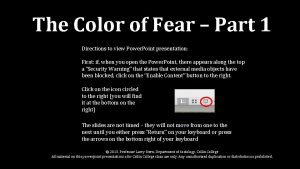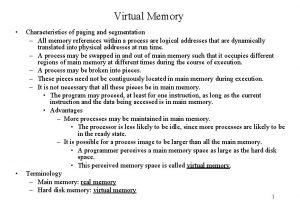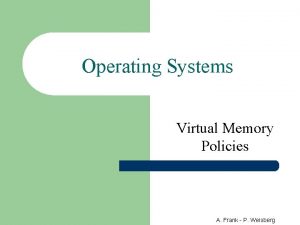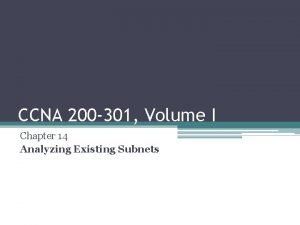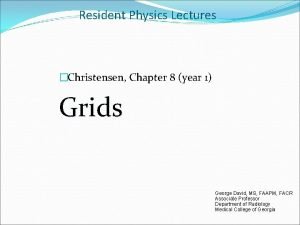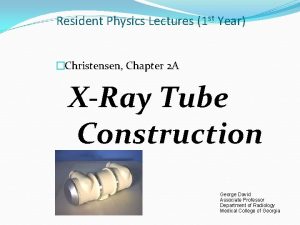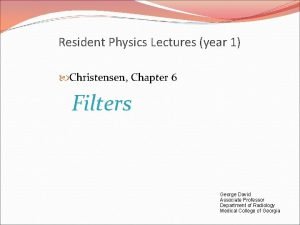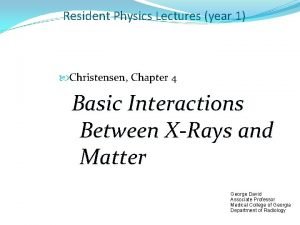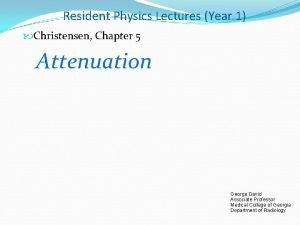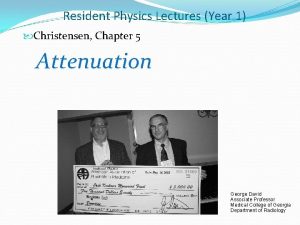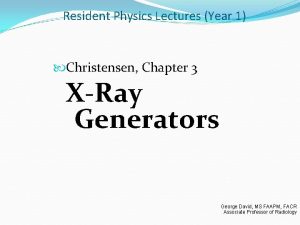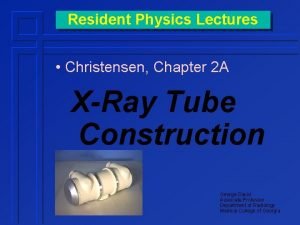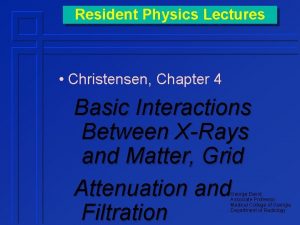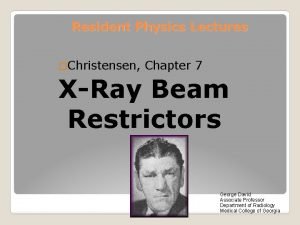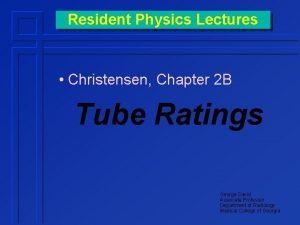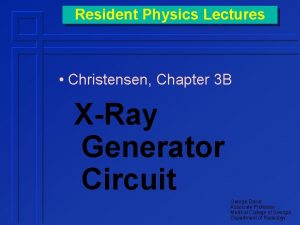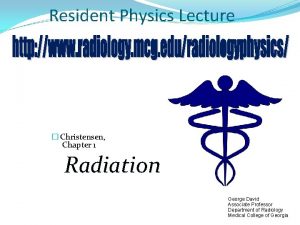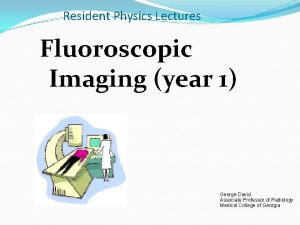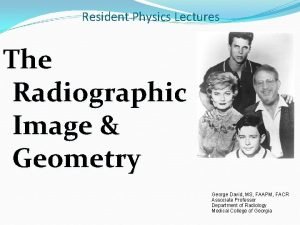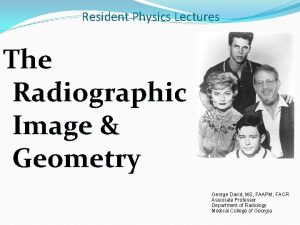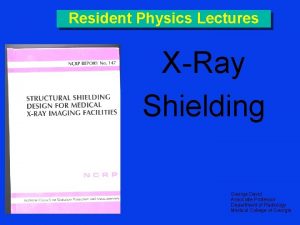Resident Physics Lectures Year 1 Christensen Chapter 3






































- Slides: 38

Resident Physics Lectures (Year 1) Christensen, Chapter 3 X-Ray Generators George David, MS FAAPM, FACR Associate Professor of Radiology

Requirements to Produce X-Rays Filament Voltage High Voltage anode + high voltage source filament voltage source

X-Ray Generator Supplies electrical power to x-ray tube high voltage between anode & cathode filament voltage Controls exposure timing Turns exposure on and off Filament heated before exposure High voltage switched on and off anode + high voltage source filament voltage source

Voltage from US power company Home 120 / 240 V 480 V 240 V Industrial Voltage required Home Most stuff: 120 V AC / Dryer: 240 V Door bell: 15 V Computer 5 V Filament: 8 -12 V High voltage: 40 -150 k. V (40, 000 – 150, 000) X-Ray

Transformers Magical devices that allow voltage to be changed to any desired value

Current Flow and Magnetic Fields Magnetic field surrounds conductor carrying electric current Magnetic field concentrated by coiling conductor Magnetic Field N Magnetic Field S Current Flow

Transformer Construction Transformers have 2 coils of wire coils not in electrical contact with each another When electric current passed through one coil magnetic field develops around first coil second coil near enough to feel magnetic field Magnetic Field Current Flow

Transformer Coil Designations Incoming AC Power Primary Coil primary coil to which power is applied secondary coil which feels magnetic field of primary coil Secondary Coil(s)

Transformer Coils When secondary coil feels changing (increasing or decreasing) magnetic field of primary coil power induced in secondary coil no physical connection Incoming AC Power Primary Coil Secondary Coil(s)

Turns Ratio Definition TR=NS / NP number of windings of secondary coil divided by number of windings of primary coil 40 / 20 for transformer below NP = 20 NS = 40

Transformer Theory transformers do not work with direct (unchanging) current (DC) Current induced in secondary coil only when primary coil current / magnetic field is changing Input DC Voltage & Current No Output Voltage Time

Transformer Theory Transformers alter both voltage & current of AC waveforms Voltage in secondary can be > or < voltage in primary Input AC Voltage & Current Output AC Voltage & Current

Transformer Law Voltage Ratio = Turns Ratio # Sec. Coils Turns Ratio = --------# Prim. Coils NS VS ----- = ----NP VP Sec. Voltage = ---------Prim. Voltage

Transformer Types Step down Transformer # primary coils > # secondary coils primary voltage > secondary voltage u Step up Transformer • # primary coils < # secondary coils • primary voltage < secondary voltage

How Does a Transformer Magically Increase Voltage without Some Source of Power?

Transformer Law (cont. ) Current ratio is inverse of voltage ratio # Sec. Coils Sec. Voltage Prim. Current --------- = ----------------# Prim. Coils Prim. Voltage Sec. Current NS VS IP ----- = ----NP VP IS VPRIM X IPRIM = VSEC X ISEC

Transformers Power = Voltage X Current Electrical power not changed Current exchanged for voltage Voltage goes up – current goes down Voltage goes down – current goes up

Power ¨ Power is rate of energy usage ¨ Power defined as Voltage X Current ¨ Units Voltage => Volts Current => Amps Power => Watts • Voltage => Kilovolts • Current => milliamps • Power => Watts

Power = Voltage X Current Transformer primary power = secondary power transformer neither creates nor consumes power Power. PRIM = Power. SEC VPRIM X IPRIM = VSEC X ISEC

Transformer Ratio = Output voltage / Input voltage Most transformers have fixed ratios X-Ray requires variable ratios Accommodate selection of different k. Vs

Autotransformer Taps Only one winding Incoming AC voltage connected across coils primary Output voltage proportional to # coils between taps secondary Input NP Primary NS Secondary

Autotransformer Voltage law for autotransformers same as for transformers Variable ratio transformer Secondary voltage adjustable by moving to a different tap changes # secondary coils NS NS VS ----- = ----NP VP Input NP Primary NS

Generator Components control console k. Vp adjust m. A adjust or m. As adjust time adjust transformer high voltage (step up) filament low voltage (step down) electronics cabinet support circuitry

X-ray Circuit Timer Circuit Autotransformer m. A selector Rectifier Circuit + Line High Voltage Transformer Filament Transformer

Timer Circuit Rectifier Circuit Autotransformer m. A selector + Line High Voltage Transformer Filament Transformer Line Incoming line voltage connected to generator through a circuit breaker. Typ. 220 -240 volt AC single phase 240, 480 volt AC three phase

Circuit Breaker Generator connected to power line through a circuit breaker Limits current from power line to generator Allows generator to be disconnected from power line Incoming Power Line Generator Circuit Breaker

Line Autotransformer m. A regulator Timer Circuit Rectifier Circuit Fixed ratio + Variable ratio High Voltage Transformer Filament Transformer • Auto transformer • Variable ratio transformer allowing operator to specify k. Vp • High voltage transformer • Boosts output of autotransformer by fixed ratio

Timer Circuit Autotransformer m. A regulator Rectifier Circuit + Line High Voltage Transformer Filament Transformer Timer • Starts & stops exposure • Turns transformer primary (low voltage) on & off

Exposure Timing Manual Operator sets time Automatic (Phototimed) Equipment measures radiation Terminates exposure when designated radiation is measured

Phototiming Detector in front of receptor Must be essentially invisible Radiation Sensor Grid Image Receptor

Phototiming Fields 1, 2, or 3 fields may be selected individually or in combination proper positioning critical

Timer Circuit Rectifier Circuit Autotransformer m. A regulator + Line High Voltage Transformer Filament Transformer Timer • Develops DC high voltage for x-ray tube

High Voltage Transformer Grounded metal box filled with oil electrical insulator Function Develops proper high voltage for tube Also contains rectifier circuit

Rectification allows current flow in one direction only Transformers only work with alternating current (AC) Rectifier changes alternating current output of high voltage transformer to direct current DC voltage applied to tube

Timer Circuit Rectifier Circuit Autotransformer m. A regulator + Line High Voltage Transformer Filament Transformer m. A regulator • Circuitry for m. A selection • Adjusts m. A on the fly during exposure.

Timer Circuit Rectifier Circuit Autotransformer m. A selector + Line High Voltage Transformer Filament Transformer Changes AC voltage to smaller voltage required by filament (8 -12 volts typical)

Power Storage Generators Use batteries Application Remote locations Inadequate power from power line or power line not accessible Outlet inaccessible

Battery-Powered Generators Batteries used for x-ray transport Independent of power line during exposure Disadvantages Require charging Heavy
 Yelena bogdan md
Yelena bogdan md Ota core curriculum
Ota core curriculum Frcr physics lectures
Frcr physics lectures Frequency of xrays
Frequency of xrays Chapter 2 the nursing assistant and the care team
Chapter 2 the nursing assistant and the care team Anteroposterior curve
Anteroposterior curve Precision fluency shaping program review
Precision fluency shaping program review Martin juul christensen
Martin juul christensen Hanau beşlisi nedir
Hanau beşlisi nedir Color of fear
Color of fear Tommy christensen gu
Tommy christensen gu Lingualized occlusion advantages
Lingualized occlusion advantages Gerald barnbaum
Gerald barnbaum Dani christensen
Dani christensen Poem for year 6 leavers assembly
Poem for year 6 leavers assembly Resident set management
Resident set management Resident retention
Resident retention Resident set management
Resident set management What is a us tin number
What is a us tin number Divine intervention episode 95
Divine intervention episode 95 Resident lifecycle
Resident lifecycle Attending vs resident
Attending vs resident Examples of misappropriation of resident property
Examples of misappropriation of resident property A helpful way for an na to respond to hallucinations is to
A helpful way for an na to respond to hallucinations is to Ambulated side
Ambulated side Partially resident textures
Partially resident textures Acgme resident survey
Acgme resident survey Employment of non-resident aliens in the philippines
Employment of non-resident aliens in the philippines Orientation and resident rights quiz
Orientation and resident rights quiz Customer service conflict resolution
Customer service conflict resolution Define resident flora
Define resident flora Resident subnet
Resident subnet Resident assessment instrument definition
Resident assessment instrument definition Tarrytown chief resident conference
Tarrytown chief resident conference Transamerica estate planning foreign nationals
Transamerica estate planning foreign nationals Resident and family engagement
Resident and family engagement Resident and family engagement
Resident and family engagement Acgme survey questions
Acgme survey questions Rick trebino lectures
Rick trebino lectures









